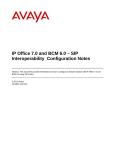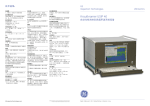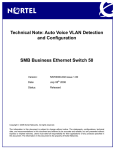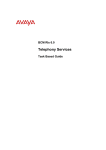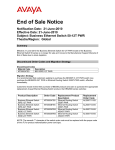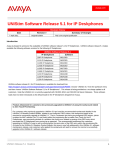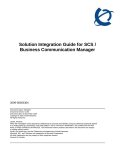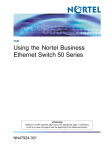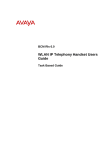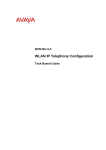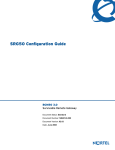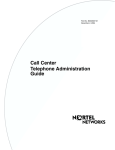Download Avaya (BES50) User's Manual
Transcript
Technical Notes QoS Features on the Business Ethernet Switch 50 (BES50) Version: NN70000-004 issue 1.00 Date: February 3rd, 2009 Status: Released Copyright © 2009 Nortel Networks. All rights reserved. The information in this document is subject to change without notice. The statements, configurations, technical data, and recommendations in this document are believed to be accurate and reliable, but are presented without express or implied warranty. Users must take full responsibility for their applications of any products specified in this document. The information in this document is the property of Nortel Networks. Technical Notes – QoS Features on BES50 Revision History Revision (Ver.Iss) 1.00 Issue Date 2009-02-03 Document Change Description Status Released First released version. . NN70000-004 issue 1.00 Copyright © 2009 Nortel Networks -2- Technical Notes – QoS Features on BES50 About this Document This application note describes the Quality Of Service (QoS) capability of BES50 family of switches. This document also outlines the procedure to properly configure different QoS features of BES50. The document is intended for people responsible for deployment and support of the Nortel Business Ethernet Switch 50. This may include: • • • • Customer System Engineering Channel Partner Engineering Nortel Solutions Engineering Knowledge Systems / Education Services NN70000-004 issue 1.00 Copyright © 2009 Nortel Networks -3- Technical Notes – QoS Features on BES50 Table of Contents Revision History .......................................................................................................................................... 2 About this Document .................................................................................................................................. 3 Table of Contents ........................................................................................................................................ 4 Table of Figures........................................................................................................................................... 5 Overview....................................................................................................................................................... 6 High-level Description of QoS Treatment in BES50 ................................................................................ 7 Configure BES50 Traffic Prioritization.................................................................................................... 14 1. Default Port Priority.............................................................................................................................. 14 2. 802.1p User Priority ............................................................................................................................. 14 3. Traffic prioritization based on IP DSCP ............................................................................................... 15 4. ACL Based Traffic prioritization .......................................................................................................... 17 BES50 Re-Marking Capability .................................................................................................................. 29 IP DSCP Re-Marking on BES50FE......................................................................................................... 29 IP DSCP Re-Marking on BES50GE ........................................................................................................ 29 Difference Between BES50FE and BES50GE......................................................................................... 32 1. Number of traffic class.................................................................................................................... 32 2. Different ways to configure ACL Based traffic prioritization ........................................................... 32 3. Location of frame/packet re-marking.............................................................................................. 32 4. IP DSCP re-marking....................................................................................................................... 32 Default QoS Behaviour of BES50FE and BES50GE .............................................................................. 33 Default QoS Behaviour on BCM Traffic................................................................................................... 33 Software Baseline ..................................................................................................................................... 35 NN70000-004 issue 1.00 Copyright © 2009 Nortel Networks -4- Technical Notes – QoS Features on BES50 Table of Figures Figure 1: BES50FE Priority to Traffic Class Mapping ................................................................................... 8 Figure 2: BES50GE Priority to Traffic Class Mapping .................................................................................. 8 Figure 3: Scheduler Queuing Mode .............................................................................................................. 9 Figure 4: BES50FE WRR Weight Settings ................................................................................................. 10 Figure 5: BES50GE WRR Weight Settings................................................................................................. 10 Figure 6: BES50FE Traffic Prioritization Flow Chart ................................................................................... 12 Figure 7: BES50GE Traffic Prioritization Flow Chart .................................................................................. 13 Figure 8: BES50 Default Port Priority Settings............................................................................................ 14 Figure 9: BES50 IP DSCP Priority Status ................................................................................................... 16 Figure 10: BES50 DSCP to COS Mapping ................................................................................................. 17 Figure 11: BES50FE Extended ACL Rule................................................................................................... 19 Figure 12: BES50FE Class Map ................................................................................................................. 20 Figure 13: BES50FE Policy Setting CoS Value .......................................................................................... 22 Figure 14: BES50FE Policy Setting DSCP Value ....................................................................................... 23 Figure 15: BES50FE Apply QoS Policy to Ingress Port.............................................................................. 24 Figure 16: BES50GE Extended ACL Rule .................................................................................................. 26 Figure 17: BES50GE ACL Priority Mapping................................................................................................ 28 Figure 18: BES50GE IP DSCP Re-Marking Status .................................................................................... 29 Figure 19: BES50GE Priority Index to IP DSCP Mapping .......................................................................... 30 NN70000-004 issue 1.00 Copyright © 2009 Nortel Networks -5- Technical Notes – QoS Features on BES50 Overview BES50 provides a number of features to support different Quality of Service (QoS) for different types of traffic. There are multiple levels of traffic prioritization on BES50 (both BES50FE and BES50GE). Prioritization can be based on (1) (2) (3) (4) Default port priority 802.1p value of the incoming tagged Ethernet frame IP DSCP of the incoming IP packet ACL based (using the 5-tuples in IP header: source and destination IP addresses, source and destination ports and protocol number) BES50 has pre-defined precedence (or order) when applying these mechanisms. ACL based prioritization has the highest precedence over the others, and default port priority has the lowest precedence if nothing else has been configured. When an incoming Ethernet frame arrives at an ingress port, BES50 first determines the traffic priority/CoS (value between 0 – 7) based on the L2/L3 information carried in the Ethernet frame and/or the IP header (IP DSCP, IP addresses, port numbers and protocol number). Each priority/CoS (basically 802.1p bit value) maps into one of the traffic class (4 classes for BES50FE and 8 classes for BES50GE). These traffic classes are served by a scheduler that can run in either Weighted Round Robin (WRR) or Strict Priority. BES50 also provides the capability to mark or re-mark the 802.1p value (CoS) or the DSCP value of the egress Ethernet frames and/or IP packets. The following table summarizes these two features: Default port priority 802.1p bit (tagged Ethernet frame) IP DSCP ACL based Egress (re) marking DSCP (IP packets) BES50GE BES50FE Yes (optional) No Traffic Prioritization Yes CoS/1p (tagged Ethernet frames) Yes Yes Yes Yes (optional) No Yes Yes Yes Yes Yes (optional) Yes (optional) No Yes (if the applied policy has an associated action to set IP DSCP value) NN70000-004 issue 1.00 Copyright © 2009 Nortel Networks -6- Technical Notes – QoS Features on BES50 High-level Description of QoS Treatment in BES50 A central element for providing different QoS treatment is the concept of traffic priority and traffic classes. When an incoming Ethernet frame arrives at an ingress port, BES50 first determines the priority/CoS (value between 0 – 7) of the incoming frame based on the L2/L3 information carried in the Ethernet frame and/or the IP payload. Each priority/CoS (basically 802.1p bit value) maps into one of the traffic class (4 classes for BES50FE and 8 classes for BES50GE). BES50 provides a default priority to traffic class mapping. The priority to traffic mapping for BES50FE and BES50GE are depicted in the following table. Priority/CoS 0 1 2 3 4 5 6 7 Traffic Class BES50FE BES50GE 1 2 0 0 0 1 1 3 2 4 2 5 3 6 3 7 Table 1: BES50 Priority to Traffic Class Mapping This mapping is also user configurable if the user desired to use a different setting. To review and/or configure the priority to traffic class mapping, navigate to the Applications > Priority > Traffic Classes panel NN70000-004 issue 1.00 Copyright © 2009 Nortel Networks -7- Technical Notes – QoS Features on BES50 Figure 1: BES50FE Priority to Traffic Class Mapping Figure 2: BES50GE Priority to Traffic Class Mapping These traffic classes are served by a scheduler that can run in either Weighted Round Robin (WRR) or Strict Priority. NN70000-004 issue 1.00 Copyright © 2009 Nortel Networks -8- Technical Notes – QoS Features on BES50 • • Strict Priority queuing operates in a pre-emptive fashion. Frames in the higher priority queues always take precedence over frames in lower priority queues. A low priority queue will not be serviced as long as there is a frame in one of the higher priority queues. When the highest priority queue is empty, frames from the other queues are serviced based on their precedence (i.e. from the higher priority queue to the lower priority queue). With strict priority queuing, it is possible that some queues may never be serviced, causing frames dropped and starvation. Use of Strict Priority queuing must be used with great care. With Weighted Round Robin queuing, each queue is assigned a weight which represents a relative proportion of time during which the queue can send packets. This technique ensures each queue gets appropriate share of bandwidth for transmitting its packets. With Weighted Round Robin, no priority is assigned to the queues. Each queue sends frames in proportion to its configured weight. BES50 uses WRR queuing by default. If the user decided to change the scheduling algorithm, navigate to the Applications > Priority > Queue Mode panel Figure 3: Scheduler Queuing Mode When running in WRR, the weight assigned to each class are pre-defined and not user configurable. To view the assigned weight for each class, navigate to the Applications > Priority > Queue Scheduling panel NN70000-004 issue 1.00 Copyright © 2009 Nortel Networks -9- Technical Notes – QoS Features on BES50 Figure 4: BES50FE WRR Weight Settings Figure 5: BES50GE WRR Weight Settings NN70000-004 issue 1.00 Copyright © 2009 Nortel Networks - 10 - Technical Notes – QoS Features on BES50 BES50 provides multiple ways to classify different types of traffic and map the traffic to one of the 8 defined priority/CoS values. There are four different methods to classify and prioritize incoming traffic, these methods are based on: 1. 2. 3. 4. Default port priority 802.1p value of the incoming tagged Ethernet frame IP DSCP of the incoming IP packet ACL based (using the 5-tuples in IP header: source and destination IP addresses, source and destination ports and protocol number) Traffic priority is determined by applying these mechanisms in a pre-defined precedence. ACL based prioritization has the highest precedence over the others, and default port priority has the lowest precedence. • • • • If ACL based prioritization is enabled and the ingress traffic matches one of the defined ACL rules, the CoS value is determined by the action associated with the configured ACL. If ACL based prioritization is disabled or the ingress traffic does not match any of the ACL rules, then the ingress traffic is subjected to IP DSCP based prioritization if this feature is enabled (IP DSCP priority is disabled by default). If the ingress Ethernet frame encapsulates an IP packet, BES50 uses the DSCP value contained in the IP header to determine the CoS value for the ingress traffic. If IP DSCP based prioritization is disabled or the ingress Ethernet frame does not encapsulate an IP packet, BES50 extracts the 802.1p value from the tagged ingress Ethernet frame to determine the appropriate CoS. If the ingress Ethernet frame is untagged, BES50 eventually use the user configurable default port priority to determine the CoS for the incoming traffic. Even though both BES50FE and BES50GE follow similar framework to prioritize incoming traffic, there are minor difference in the way these mechanisms are implemented. • • BES50FE maps traffic directly into a CoS/priority value, which in turns identifies the traffic class which will be used for the frame or packet. BES50GE first maps traffic into a priority index, which in turns maps into a CoS/priority value to identify the traffic class which will be used for the frame or packet. The following two figures illustrate the flow chart of how traffic prioritization is achieved in both BES50FE and BES50GE. NN70000-004 issue 1.00 Copyright © 2009 Nortel Networks - 11 - Technical Notes – QoS Features on BES50 Process Ingress Ethernet Frame Match QoS Policy? Yes Action is “Set DSCP”? Yes Set IP DSCP Get CoS from DSCP No (action is “Set CoS”) No Yes IP DSCP Enabled? Is it an IP packet? Yes Get CoS from DSCP No No Tagged Ethernet Frame? No Yes Get CoS from 802.1p value Set CoS Get default port priority Figure 6: BES50FE Traffic Prioritization Flow Chart NN70000-004 issue 1.00 Copyright © 2009 Nortel Networks - 12 - Technical Notes – QoS Features on BES50 Process Ingress Ethernet Frame Yes Match ACL Mapping? No Yes IP DSCP Enabled? Is it an IP packet? Yes Map DSCP to Priority Index No No Tagged Ethernet Frame? No Yes Get default port priority Get CoS from 802.1p value Map CoS to Priority Index Get IP DSCP Get Priority Index Set CoS Figure 7: BES50GE Traffic Prioritization Flow Chart The resulting priority/CoS (basically 802.1p bit value) maps into one of the traffic class (4 classes for BES50FE and 8 classes for BES50GE). These traffic classes are served by a scheduler that can run in either Weighted Round Robin (WRR) or Strict Priority. To review and/or configure the traffic priority to traffic class mapping, navigate to the Applications > Priority > Traffic Classes panel (see “Figure 1: BES50FE Traffic Classes” and “Figure 2: BES50GE Traffic Classes”). NN70000-004 issue 1.00 Copyright © 2009 Nortel Networks - 13 - Technical Notes – QoS Features on BES50 Configure BES50 Traffic Prioritization 1. Default Port Priority A default port priority can be specified for each port on the BES50. All untagged packets entering the BES50 are tagged with the specified default port priority, and then sorted into the appropriate priority queue at the output port. The default priority applies for an untagged frame received on a port set to accept all frame types (i.e, can receive both untagged and tagged frames). The default port priority does not apply to IEEE 802.1Q VLAN tagged frames. If the incoming frame is an IEEE 802.1Q VLAN tagged frame, the IEEE 802.1p User Priority bits contained in the Ethernet frame will be used for traffic prioritization. If the egress port is an untagged member of the associated VLAN, the egress frames are stripped of all VLAN tags prior to transmission. To review and/or modify the default port priority settings, navigate to the Applications > Priority > Default Port Priority panel. Figure 8: BES50 Default Port Priority Settings 2. 802.1p User Priority BES50 can use the IEEE 802.1p user priority embedded in the incoming tagged Ethernet frames to determine the appropriate user traffic priority. Up to 8 traffic priorities are defined in IEEE 802.1D. BES50 provides a default user priority to traffic class mapping in accordance with Annex G of the IEEE 802.1D (keep in mind there are 4 traffic classes for BES50FE and 8 traffic classes for BES50GE). This mapping is also user configurable if the user desired to use a different mapping. To review and/or configure the traffic priority to traffic class mapping, navigate to the Applications > Priority > Traffic Classes panel (see Figure 1: BES50FE Priority to Traffic Class and Figure 2: BES50GE ). NN70000-004 issue 1.00 Copyright © 2009 Nortel Networks - 14 - Technical Notes – QoS Features on BES50 3. Traffic prioritization based on IP DSCP This section focuses on prioritizing traffic based on the IP DSCP value in the incoming IP packets. In brief, the user first needs to enable IP DSCP prioritization (it is disabled by default). When an incoming IP packet arrives at an ingress port, BES50 first maps the DSCP value in the incoming IP packet to a traffic priority/CoS (value between 0 – 7). Each traffic priority/CoS is mapped to one of the traffic classes, each traffic class will be serviced by the scheduler. Keep in mind that the IP DSCP field of an IP packet is 6 bits while the 802.1p field of an Ethernet frame is only 3 bits, there are a lot more IP DSCP value combination than the 802.1p value. BES50 provides a default DSCP to CoS mapping as depicted in the following table. The DSCP to CoS mapping is also user configurable if the user desired to use a different setting. IP DSCP Value 0 8 10, 12, 14, 16 18, 20, 22, 24 26, 28, 30, 32, 34, 36 38, 40, 42 48 46, 56 CoS Value 0 1 2 3 4 5 6 7 Table 2: BES50 IP DSCP to CoS Mapping E.g. • • DSCP value of 40 or 0x28 maps into CoS 5, and then maps into traffic class 2 in BES50FE or traffic class 5 in BES50GE DSCP value of 46 or 0x2e maps into CoS 7, and then maps into traffic class 3 in BES50FE or traffic class 7 in BES50GE. NOTE: When IP DSCP prioritization is enabled, in the event that that the incoming Ethernet frame is also tagged with an 802.1p value, BES50 will use the DSCP value in the IP packet for traffic prioritization instead of the 802.1p value in the Ethernet frame. Step (1) Enable IP DSCP Prioritization BES50 has the capability to prioritize traffic based on DSCP of the incoming IP packet. By default this feature is disabled, the user has to enable it if desired. Each DSCP is mapped into a CoS/priority, which in turns in mapped into one of the traffic class. Navigate to the Applications > Priority > IP DSCP Status panel NN70000-004 issue 1.00 Copyright © 2009 Nortel Networks - 15 - Technical Notes – QoS Features on BES50 Figure 9: BES50 IP DSCP Priority Status Step (2) Configure/Check DSCP to CoS mapping BES50 has a predefined DSCP to CoS mapping. However the users can still modify the mapping if they desired. Navigate to the Applications > Priority > IP DSCP Priority panel NN70000-004 issue 1.00 Copyright © 2009 Nortel Networks - 16 - Technical Notes – QoS Features on BES50 Figure 10: BES50 DSCP to COS Mapping 4. ACL Based Traffic prioritization Using the ACL classification rules, BES50 can also prioritize traffic based on the following IP header information of the incoming IP packets: • • • • • Source IP address Destination IP address Source port number Destination port number Protocol ID Even though both BES50FE and BES50GE support traffic prioritization based on these five tuples in the IP header, the configuration process on these two units are different from each other. BES50FE Configuration Step (1) Define the traffic classifier in an extended Access Control List (ACL) This step describes the classification criteria to identify a subset of incoming traffic for the desired QoS treatment. The criteria are based on the five tuples in the IP header. NOTE: The action associated with the ACL rule MUST be set to “Permit”. NN70000-004 issue 1.00 Copyright © 2009 Nortel Networks - 17 - Technical Notes – QoS Features on BES50 NN70000-004 issue 1.00 Copyright © 2009 Nortel Networks - 18 - Technical Notes – QoS Features on BES50 Figure 11: BES50FE Extended ACL Rule Step (2) Define a class map that matches the classification of the ACL This step identifies the matching traffic as a traffic stream. All packets within the same traffic stream are subject to the same QoS policy. NN70000-004 issue 1.00 Copyright © 2009 Nortel Networks - 19 - Technical Notes – QoS Features on BES50 Figure 12: BES50FE Class Map NN70000-004 issue 1.00 Copyright © 2009 Nortel Networks - 20 - Technical Notes – QoS Features on BES50 Step (3) Define a QoS policy for the selected traffic stream A QoS policy determines the course of action applying to incoming IP packets that belong to the same traffic stream. The action can be mark/re-mark IP DSCP or mark/re-mark the CoS priority of the incoming Ethernet frames. BES50FE will provide QoS treatment based on the new IP DSCP or CoS value: • CoS: The new CoS value maps into one of the traffic class based on the CoS to traffic class mapping (see Figure 1: BES50FE Priority to Traffic Class). NOTE: Using a QoS policy to set the new CoS value will not modify the DSCP of the affected IP packet. Only the 802.1p value of the egress Ethernet frame (that encapsulated the affected IP packet) will be modified. NN70000-004 issue 1.00 Copyright © 2009 Nortel Networks - 21 - Technical Notes – QoS Features on BES50 Figure 13: BES50FE Policy Setting CoS Value • IP DSCP: The new DSCP value first maps into a CoS priority value based on a defined DSCP-toCoS mapping (see Figure 10: BES50 DSCP to COS Mapping). The new CoS value is then mapped into one of the traffic class based on the CoS to traffic class mapping (see Figure 1: BES50FE Priority to Traffic Class). NN70000-004 issue 1.00 Copyright © 2009 Nortel Networks - 22 - Technical Notes – QoS Features on BES50 NOTE: Using a QoS policy to set the new IP DSCP will modify the DSCP value of the target IP packet as well as the 802.1p value of the egress Ethernet frame (that encapsulated the target IP packet). Figure 14: BES50FE Policy Setting DSCP Value NN70000-004 issue 1.00 Copyright © 2009 Nortel Networks - 23 - Technical Notes – QoS Features on BES50 Step (4) Apply the QoS policy to an ingress port This step applies the QoS policy to an ingress port. Traffic classification and marking/re-marking are carried out at the ingress port where the incoming IP packets enter the BES50FE switch. Figure 15: BES50FE Apply QoS Policy to Ingress Port BES50GE Configuration Step (1) Define the traffic classifier in an extended Access Control List (ACL) This step describes the classification criteria to identify a subset of incoming traffic for the desired QoS treatment. The criteria are based on the five tuples in the IP header. NOTE: The action associated with the ACL rule MUST be set to “Permit”. NN70000-004 issue 1.00 Copyright © 2009 Nortel Networks - 24 - Technical Notes – QoS Features on BES50 NN70000-004 issue 1.00 Copyright © 2009 Nortel Networks - 25 - Technical Notes – QoS Features on BES50 Figure 16: BES50GE Extended ACL Rule Step (2) Bind ACL classification rule to an ingress port This step binds the ACL classification rule to an ingress port. Traffic classification is carried out at the ingress port where the incoming IP packets enter the BES50GE switch. All packets that match the classification rule are considered as belonging to the same traffic stream. 1 A priority index is assigned to the traffic stream which is then mapped into one of the 8 CoS value. Since IP DSCP is a 6 bits value, there are more than 8 different combinations of valid DSCP value. A one-toone priority index to CoS mapping limits the egress DSCP marking/remarking to only 8 DSCP values. BES50 defines 16 priority index and a non-configurable Priority Index to CoS mapping, which are used in both QoS treatment and IP DSCP marking/re-marking. 1 Unlike BES50FE, Ethernet frame and IP packet marking/re-marking is performed on the egress side of BES50GE when the Ethernet frame is transmitted. NN70000-004 issue 1.00 Copyright © 2009 Nortel Networks - 26 - Technical Notes – QoS Features on BES50 Priority Index 0 1 2 3 4 5 6 7 8 9 10 11 12 13 14 15 CoS Value 0 1 2 3 4 5 6 7 0 1 2 3 4 5 6 7 Table 3: BES50GE Priority Index to CoS Mapping NN70000-004 issue 1.00 Copyright © 2009 Nortel Networks - 27 - Technical Notes – QoS Features on BES50 Figure 17: BES50GE ACL Priority Mapping NN70000-004 issue 1.00 Copyright © 2009 Nortel Networks - 28 - Technical Notes – QoS Features on BES50 BES50 Re-Marking Capability In addition to traffic prioritization, BES50 also provides the capability to re-mark the IP DSCP value of an outgoing IP packet and the 802.1p value (CoS) of an outgoing Ethernet frame. IP DSCP Re-Marking on BES50FE Figure 6: BES50FE Traffic Prioritization Flow Chart depicts the flow chart of how CoS/priority is determined by BES50FE. Re-marking in BES50FE is a simple extension to this process. BES50FE always re-marks the 802.1p value of the tagged egress Ethernet frame with the determined CoS/priority value. On the other hand, BES50FE will only re-mark IP DSCP of the outgoing IP packet if the matched QoS Policy has an associated “Set IP DSCP” action (see Figure 14: BES50FE Policy Setting DSCP Value). IP DSCP Re-Marking on BES50GE Figure 7: BES50GE Traffic Prioritization Flow Chart depicts the flow chart of how the priority index and CoS/priority are determined by BES50GE. Just like BES50FE, BES50GE always re-marks the 802.1p value of the tagged egress Ethernet frame with the determined CoS/priority value. Re-marking IP DSCP in BES50GE is slightly different from BES50FE. By default, IP DSCP re-marking is disabled on all the ports. The user must manually enable IP DSCP remarking on the egress port (i.e. the port in which IP packet is emitted out from BES50GE) if they desired to do so. To enable/disable IP DSCP re-marking on an egress port, navigate to the Applications > Priority > Marker Status panel. Figure 18: BES50GE IP DSCP Re-Marking Status NN70000-004 issue 1.00 Copyright © 2009 Nortel Networks - 29 - Technical Notes – QoS Features on BES50 BES50GE provides a default priority index to IP DSCP mapping, and this mapping is also user configurable if they desired to use a different setting. To review and/or configure the traffic index to IP DSCP mapping, navigate to the Applications > Priority > Priority to DSCP panel. Figure 19: BES50GE Priority Index to IP DSCP Mapping When IP DSCP re-marking is enabled, BES50GE always re-mark the DSCP value of all IP packets emitted from that egress port based on the priority index determined by BES50GE. The re-marking process is summarized as follows: • • If the egress port is not configured to re-mark IP DSCP or the outgoing Ethernet frame does not encapsulate an IP packet, then BES50GE will skip the IP DSCP re-marking process. If the egress port is configured to re-mark IP DSCP and the outgoing Ethernet frame encapsulates an IP packet, BES50GE will use the resulting priority index associated with the Ethernet frame to determine the corresponding DSCP value. The outgoing IP packet will be re-mark with this new DSCP value. The following table combines the default Priority Index to CoS mapping and the default Priority Index to IP DSCP to illustrate the respective values used in CoS re-marking and IP DSCP re-marking mapped from the same priority index. NN70000-004 issue 1.00 Copyright © 2009 Nortel Networks - 30 - Technical Notes – QoS Features on BES50 Priority Index 0 1 2 3 4 5 6 7 8 9 10 11 12 13 14 15 CoS Value IP DSCP 0 1 2 3 4 5 6 7 0 1 2 3 4 5 6 7 0 10 12 14 18 20 22 26 28 30 34 36 38 46 0 0 Table 4: BES50GE Priority Index to CoS and IP DSCP Mapping A word of caution when IP DSCP based traffic prioritization is enabled. Since the DSCP value is 6 bits and there are only 8 CoS/priority value, enabling IP DSCP remarking may alter IP DSCP to an undesirable value. The following table combines the default DSCP to CoS mapping with Table 4: BES50GE Priority Index to CoS and IP DSCP Mapping. Ingress IP DSCP Value 0 8 10, 12, 14, 16 18, 20, 22, 24 26, 28, 30, 32, 34, 36 38, 40, 42 48 46, 56 CoS Value 0 1 2 3 4 5 6 7 Priority Index 0 1 2 3 4 5 6 7 Egress IP DSCP Value 0 10 12 14 18 20 22 25 E.g. If IP DSCP traffic prioritization is enabled and the incoming IP packet with DSCP value of 36 does not match any one of the ACL rules, BES50GE will map the traffic to the traffic class 4 with a corresponding priority index value 4. When IP DSCP re-marking is enabled at the egress port, BES50 will map the priority index value 4 to IP DSCP value 18 and re-mark the outgoing IP packet with this value. NN70000-004 issue 1.00 Copyright © 2009 Nortel Networks - 31 - Technical Notes – QoS Features on BES50 Difference Between BES50FE and BES50GE 1. Number of traffic class BES50FE has four traffic classes, while BES50GE has eight traffic classes. 2. Different ways to configure ACL Based traffic prioritization BES50FE uses the “QoS Policy” to facilitate ACL based traffic prioritization (see Figure 15: BES50FE Apply QoS Policy to Ingress Port), while BES50GE uses the “ACL Priority Mapping” to map traffic matching the ACL to a specified priority index (see Figure 17: BES50GE ACL Priority Mapping). 3. Location of frame/packet re-marking BES50FE classifies and re-mark CoS/DSCP at the ingress port (i.e. the port in which the Ethernet frame enters BES50FE) of the switch. In contrast, BES50GE classifies traffic at the ingress port but re-mark CoS/DSCP at the egress port (i.e. the port in which the Ethernet frame is emitted from BES50GE) of the switch. 4. IP DSCP re-marking Both BES50FE and BES50GE support re-marking of the DSCP value of an IP packet. However, there are subtle differences in terms of how the IP packet is re-marked: • • • • BES50FE re-marks packets on a per traffic stream level (i.e. all traffic that matches the same QoS policy configured on a specific ingress port). BES50GE re-marks packets on a per port basis, specifically IP packets that are emitted from an egress port with IP DSCP re-marking enabled. BES50FE only re-marks DSCP value of the IP packets that match a “QoS Policy” with an associated “Set IP DSCP” action. If re-marking is enabled on an egress port, BES50GE always re-mark the DSCP value of all IP packets emitted from that egress port based on the priority index determined by BES50GE. NN70000-004 issue 1.00 Copyright © 2009 Nortel Networks - 32 - Technical Notes – QoS Features on BES50 Default QoS Behaviour of BES50FE and BES50GE BES50 provides a set of default (out of the box) settings that are captured in the following table: Traffic Prioritization Method Default port priority 802.1p bit (tagged Ethernet frame) IP DSCP ACL based Default Status Enabled Enabled Disabled Disabled Default CoS/Priority Value 0 Taken from 802.1p value of the incoming tagged Ethernet frames N/A N/A Table 5: Default QoS Settings of BES50 Without modifying the default settings, the followings describe the default QoS behaviour of both BES50FE and BES50GE: • If the incoming Ethernet frame is a tagged frame, BES50 will take the 802.1p value specified in the VLAN tag as the CoS/priority value. This CoS value is used to put the incoming frame into one the of traffic classes (see Table 1: BES50 Priority to Traffic Class Mapping). • If the incoming Ethernet frame is an untagged frame, BES50 will use the default port priority value ‘0’ as the CoS/priority and maps the frame into one of the traffic classes (see Table 1: BES50 Priority to Traffic Class Mapping). o o For BES50FE, CoS value of ‘0’ maps into traffic class 1. For BES50GE, CoS value of ‘0’ maps into traffic class 2. This means that only tagged Ethernet frames with 802.1p value of either 1 or 2 will have lower priority than the untagged Ethernet frames. • The IP DSCP value specified in the IP header has no effect on the default QoS behaviour of BES50 switches. Incoming traffic is prioritized based on either the 802.1p value of the tagged Ethernet frames or the default priority value of ‘0’ for all the untagged Ethernet frames. • Since both BES50GE and BES50FE do not alter the CoS value, there is no 802.1p re-marking of any Ethernet frames switched through BES50. • By default, IP DSCP re-marking is disabled on both BES50FE and BES50GE. Default QoS Behaviour on BCM Traffic Since both BCM50 and BCM450 do not have VLAN capability, all the Ethernet frames transmitted from the BCM must be untagged Ethernet frames. When a BCM (either BCM50 or BCM450) is connected to a BES (either BES50FE or BES50GE) with default QoS settings, all the traffic transmitted from BCM will map to the same traffic class. Effectively there is no service differentiation among the traffic transmitted from the BCM. In the presence of Ethernet traffic from other L2 devices, only tagged Ethernet frames with 802.1p value of either 1 or 2 will have lower priority than the traffic transmitted from BCM. Default QoS treatment on the Ethernet frame sent to BCM is solely depending on whether the frame is tagged when it arrives at the ingress port of the BES50. The BES50 behaviour is captured in the section titled “Default QoS Behaviour of BES50FE and BES50GE”. NN70000-004 issue 1.00 Copyright © 2009 Nortel Networks - 33 - Technical Notes – QoS Features on BES50 When BES50 is used in a customer premises network with BCM50/BCM450 and QoS treatment is required, it is recommended to use the IP DSCP traffic prioritization method (see “3. Traffic prioritization based on IP DSCP” on page 15) on BES50 since BCM does not tag outgoing Ethernet frames. It is also recommended not to enable IP DSCP re-marking on BES50 so all QoS capable devices within the customer premise network will apply the same DiffServ QoS behaviour to the IP packets passing through the network. Typically DSCP is re-marked if necessary when IP packets traverse across DiffServ boundary. BES50 is a layer 2 device, re-marking DSCP is better off performed by a layer 3 router (or gateway) locating at the edge of two DiffServ boundary. NN70000-004 issue 1.00 Copyright © 2009 Nortel Networks - 34 - Technical Notes – QoS Features on BES50 Software Baseline This application note draws upon the capabilities available from the following BES50 software releases: • • BES50FE v1.0.3.0 (Release 1.1) BES50GE v1.0.5.0 (Release 1.1) NN70000-004 issue 1.00 Copyright © 2009 Nortel Networks - 35 -



































